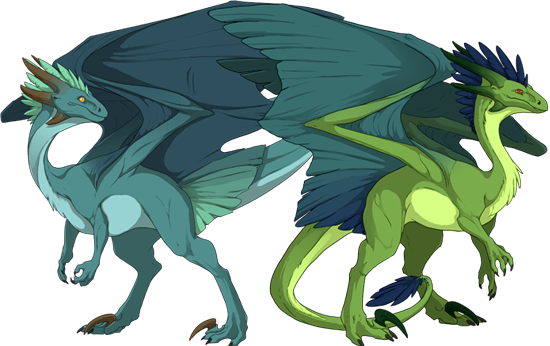
Wildclaw Dragons
Information relating to the fierce Wildclaw dragon species.
 | Obtained: Rarity:
Breeding Cooldown: Diet:
|
The Wildclaw breed originates from Shrieking Wilds where its population remains abundant. This species has begun to expand into new domains, the most notable of which is The Wandering Contagion. This territory supports the second largest population of Wildclaw dragons, which some consider to be unusual given the homeland of the species. To say that these two regional groups do not get along is an understatement, and most encounters between the two populations trend towards bloodshed.
Physical Attributes:
Wildclaw are a bipedal species of dragon. Their powerful hind legs excel at launching them into the air and enabling them to slash at their prey. The shorter front legs possess dexterous claws and opposable thumbs. Wildclaws display little sexual dimorphism, with both male and females possessing a crown of six horns and a crest of feathers. Females of the species are on-average slightly larger than their male counterparts.
Social:
Wildclaw hierarchy revolves around physical might and hunting prowess. A dragon's station is dictated by their ability to provide for the clan, with the best hunters and fighters being awarded positions of power. Dragons may challenge those who have offended them to a duel, no matter how small or fabricated the infraction. Truly a society of "might makes right", arguments that can't be won with logic may be won with tooth and claw. To decline a duel is to admit that one was in the wrong, for the truth of one's words is something worth fighting for. Declining a duel will lower a Wildclaw's position in the clan far more than losing a duel, though participating in the duel comes with the risk of losing one's life.
Lairs:
Wildclaw lairs are colorful and ornamented. Dragons who are of lower ranking are encouraged to take up professions that allow them to beautify and enhance the dwelling of the clan. Chambers of the upper echelons of Wildclaw society are covered in intricate murals depicting the past victories of the occupants. These walls are stripped and repainted whenever there is movement in the hierarchy, much to the grief of the artists.
Nests are sequestered away from the clan lair. A large family tree is considered prestigious; rivals have been known to pilfer and rear the eggs of their enemies to grow the branches of their family tree more swiftly. Choosing a strong mate is important for incubation and rearing of any clutch. In each pairing the dragon with the greatest physical prowess is given the honor of brooding over the nest until it hatches, while its partner is required to scout the surrounding territory for enemies and provide for their family. When hatchlings have fully imprinted upon their parents, the family will move back into the clan's lair.
Tactics:
Wildclaws hunt and fight alone or in pairs. Those who are bonded to a dragon of a different species will always fight alone. Some theorize this is to protect their physically inferior (but no doubt lovable) partner by keeping dangers at a safe distance from them. While Wildclaw are adept at silent movement on the ground, when confronting another dragon they will address the enemy head-on by flaring their wings and shrieking their challenge.
